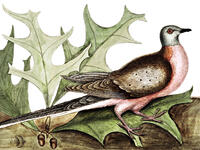
The two talks described below are part of a series webinar talks focused on the theme of “Mass Extinction: Art, Ritual, Story, and the Sacred”, part of the broader Religion, Ecology, and Expressive Culture Initiative at the Yale Institute of Sacred Music. Register here.
Dead as a Dodo: Visualizing Anthropocene Extinction in the Early Modern World by Sugata Ray
Among the many species that went extinct in the last five hundred years or so under colonial regimes globally, it is the ill-fated dodo (Raphus cucullatus) endemic to the Indian Ocean island of Mauritius that became an early icon of the Anthropocene Extinction. This talk turns to early modern visual representations of the bird by Western European artists such as Roelandt Savery to explore the unequivocal complicity between imperialism and aesthetic regimes in casting ecocide as the de facto story of European modernity’s global teleology. While much has been written on the biotechnological apparatuses that expedited the extinction of the dodo in the seventeenth century under Dutch colonialism, I argue that imperial artistic cultures played an equally vital role in presenting nonhuman extinction as a form of incommensurability with the socio-environmental transformations that were part and parcel of the global dispersion of Western European modernity.
Sugata Ray is associate professor of South and Southeast Asian art and architecture in the Departments of History of Art and South & Southeast Asian Studies. Ray’s recent books include Climate Change and the Art of Devotion: Geoaesthetics in the Land of Krishna, 1550–1850 (2019; awarded the Society of Architectural Historians of Great Britain’s Alice Davis Hitchcock Medallion and the American Academy of Religion’s Religion and the Arts Book Award) and Water Histories of South Asia: The Materiality of Liquescence (coedited; 2020). He is currently writing a book on Anthropocene extinction in the early modern period.
Creating, Thinking and Feeling Through Extinction by Stefan Skrimshire
Skrimshire reflects on lessons learned from a collaborative project in the UK that brought together performing and visuals artists, refugees and asylum seekers, Buddhist monks, and members of the public, to explore embodied responses to the mass extinction crisis. He reflects on the challenges of exploring a topic at once conceptually complex, emotionally overwhelming, politically charged, and spiritually evocative, and ask: what role do the arts have to play in helping us negotiate these challenges? He hopes to show part of the video artwork by artist Lou Chapelle that was commissioned as part of the project.
Stefan Skrimshire is an associate professor of Theology and Religious Studies at the University of Leeds, UK. His teaching covers two main areas: political / ecological theology and continental philosophy. His research focus is the theological and philosophical dimensions of climate change and ecological activism; more specifically, the legacy of Christian apocalyptic, utopian and eschatological belief on extinction narratives. I am leading three research projects in this area: ‘Religion and Extinction’, ‘Thinking Through Extinction’, and the Leverhulme Extinction Studies Doctoral Training Programme.